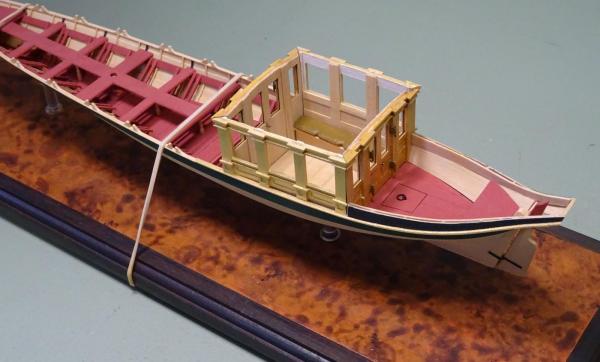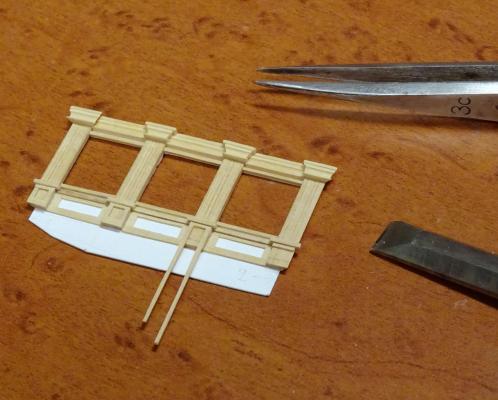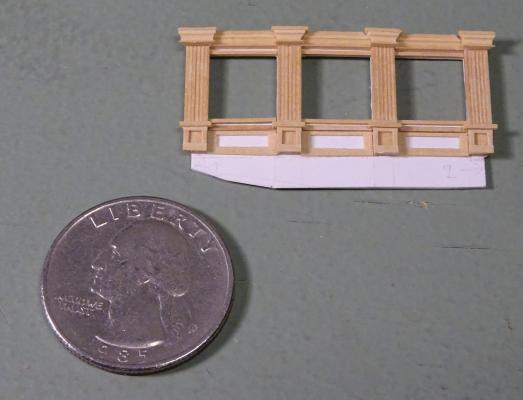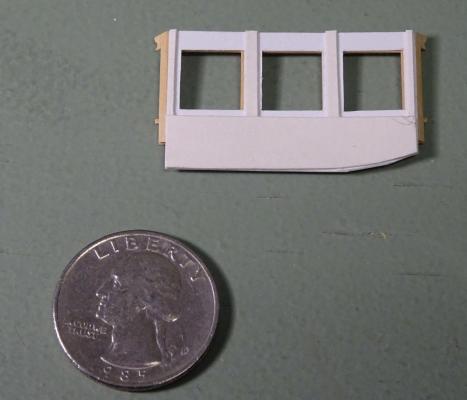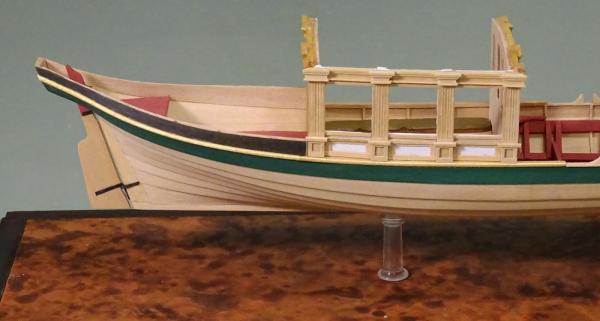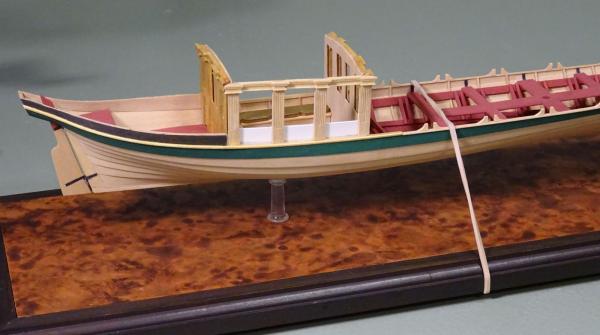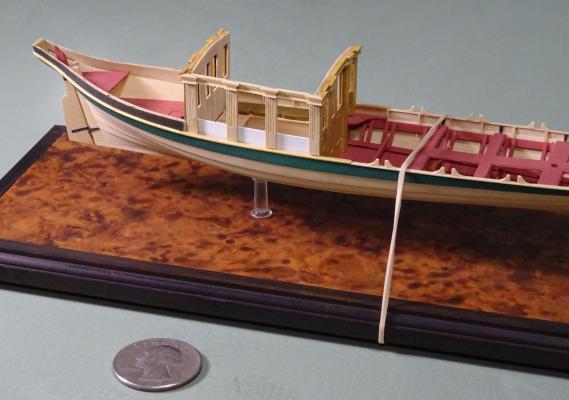-
Posts
13,274 -
Joined
-
Last visited
Content Type
Profiles
Forums
Gallery
Events
Everything posted by druxey
-
Looks like you've already answered your own question!
- 649 replies
-
- dunbrody
- famine ship
-
(and 2 more)
Tagged with:
-
Thanks, gentlemen. Joel: The access scuttle was, I believe, for bailing. There were lockers beneath the coach seating. Glenn: Mica was traditionally used on many contemporary models so, nothing new under the sun! Paul: The hinges are simple to make. Cut a strip of paper whose width is the height of the hinge leaf. Lay it down on a flat surface and place a length of 'pin' of suitable diameter across it at right angles. Glue the strip for a little way on one side of the 'pin' and fold over. Press the paper strip snugly against the pin. Let this dry. Paint the assembly a suitable color. Trim the pin and leaves to length and install.
- 641 replies
-
- greenwich hospital
- barge
-
(and 1 more)
Tagged with:
-
Are you sure you don't want to build the whole hull? Looking very neatly done, Frank. One way to ensure the frames are plumb is to glue a temporary cross-spall across the top of the frames and mark the centreline. This will ensure symmetry across the hull. Two set squares will ensure plumb as well as at right angles to the keel.
- 649 replies
-
- dunbrody
- famine ship
-
(and 2 more)
Tagged with:
-
Elegantly done, Ed! Those look perfect.
- 3,618 replies
-
- young america
- clipper
-
(and 1 more)
Tagged with:
-
Thanks for dropping by, everyone. The outer sides of the coach have been completed and gilded. The coach is only test-fitted together at present. I'm now in the process of panelling the inner sides and refining the fit of the corners of the coach. The latter needs particular care: take too much material off a corner and.... The door hardware has been added. The door knobs are of brass wire whose ends have been melted. If done correctly, the ends of the wire will form a small spherical ball. The 'bronze' hinges are pieces of bamboo treenail and paper, acrylic painted.
- 641 replies
-
- greenwich hospital
- barge
-
(and 1 more)
Tagged with:
-
Thanks for the clarification over the direction of the keel scarph, Frank.
- 649 replies
-
- dunbrody
- famine ship
-
(and 2 more)
Tagged with:
-
Learner: I didn't miss the panels: I simply took the photos while the sides were in the process of being built up! Grant: Yes, it's true. Even professionals have to re-do things. Errare humanum est and all that. Thanks for looking in, everyone.
- 641 replies
-
- greenwich hospital
- barge
-
(and 1 more)
Tagged with:
-
Thanks once more for the likes and comments, everyone. I had to re-do the side of the coach. I found that I had cut the lights to the wrong depth. In addition, the lights were uneven in width. So, a second round. When dealing with tiny pieces, I've found it easiest to leave them over-length to glue them on (top photo). I then use a chisel to cut the pieces to exact length. The top and bottom pieces of the panel frame were cut a little overlength, then sanded using a sanding stick to trim them to exact dimension (second photo). The inner side of the piece has had card strips glued on to leave channels for the glazing (third photo). In this case I shall be using mica. This is a naturally occurring mineral that is fairly transparent. It can be peeled into very thin layers and cuts easily. The pieces will be slid into place from above before the roof is installed. The cutaway at the bottom of the side is because the hull curves inward here and this allows for the changing interior contour. The last photo shows the work to this point. Next will be the inside panelling and the other side piece.
- 641 replies
-
- greenwich hospital
- barge
-
(and 1 more)
Tagged with:
-
Hmm.... If I may make another suggestion: at midships, the lines of the joints shouldl be spaced apart about equally. The uppermost line should move down so that it is just below the wale. Then I think you are gold.
- 525 replies
-
- anchor hoy
- hoy
-
(and 1 more)
Tagged with:
-
The first of the two coach sides is now in the process of being constructed. These are built up in the same way as the fore and aft ends of the coach. As there is a slight curve to the sides, allowance is made for some flex between each of the three lights. Toni: to answer your question, I'm delaying a final judgement on the degree of reflectivity of the gold until the model nears completion. Also, the photographs don't really give the effect of the actual appearance to the eye.
- 641 replies
-
- greenwich hospital
- barge
-
(and 1 more)
Tagged with:
-

Frégate d'18 par Sané , la Cornélie
druxey replied to JohnE's topic in CAD and 3D Modelling/Drafting Plans with Software
Looking good, John! Now all we need is some representative decorative work.... -
Thanks for explaining your method of getting these floors out, Gerald.
- 281 replies
-
- falls of clyde
- tanker
-
(and 2 more)
Tagged with:
-
That looks very nice now, Maury. I think you'll be glad to have made those revisions. Now you need to figure out the lines of joints on the body plan.
- 525 replies
-
- anchor hoy
- hoy
-
(and 1 more)
Tagged with:
-
Those are really nice fittings, Nils.
- 2,625 replies
-
- kaiser wilhelm der grosse
- passenger steamer
-
(and 1 more)
Tagged with:
-

Cutter Cheerful 1806 by rafine - FINISHED
druxey replied to rafine's topic in - Build logs for subjects built 1801 - 1850
Excellent finish, Bob! I really like the anchor puddening!- 525 replies
-
- cheerful
- Syren Ship Model Company
-
(and 1 more)
Tagged with:
-
Alan G: The original timber used was probably larch. A Royal barge draught of 1823 (ZAZ7154) has the notation "To be built of Larch, or other light and durable wood." And yes, I've used trompe l'oeil techniques before, both on baseboards as well as theatrical and film furniture and sets.
- 641 replies
-
- greenwich hospital
- barge
-
(and 1 more)
Tagged with:
-
I wasn't challenging you or your calculations, Jud, just suggesting an empirical experiment! Sorry if what I wrote sounded more aggressive than I meant it to.
-
Louie: Gesso gives a nice, smooth white surface that takes pencil or ink well when marking out planking runs and butts.
- 641 replies
-
- greenwich hospital
- barge
-
(and 1 more)
Tagged with:
-
Harland made the point that at intermediate angles, the slackness/tightening varies in a very non-linear fashion. Did you take this into account on your calculation?
About us
Modelshipworld - Advancing Ship Modeling through Research
SSL Secured
Your security is important for us so this Website is SSL-Secured
NRG Mailing Address
Nautical Research Guild
237 South Lincoln Street
Westmont IL, 60559-1917
Model Ship World ® and the MSW logo are Registered Trademarks, and belong to the Nautical Research Guild (United States Patent and Trademark Office: No. 6,929,264 & No. 6,929,274, registered Dec. 20, 2022)
Helpful Links
About the NRG
If you enjoy building ship models that are historically accurate as well as beautiful, then The Nautical Research Guild (NRG) is just right for you.
The Guild is a non-profit educational organization whose mission is to “Advance Ship Modeling Through Research”. We provide support to our members in their efforts to raise the quality of their model ships.
The Nautical Research Guild has published our world-renowned quarterly magazine, The Nautical Research Journal, since 1955. The pages of the Journal are full of articles by accomplished ship modelers who show you how they create those exquisite details on their models, and by maritime historians who show you the correct details to build. The Journal is available in both print and digital editions. Go to the NRG web site (www.thenrg.org) to download a complimentary digital copy of the Journal. The NRG also publishes plan sets, books and compilations of back issues of the Journal and the former Ships in Scale and Model Ship Builder magazines.



